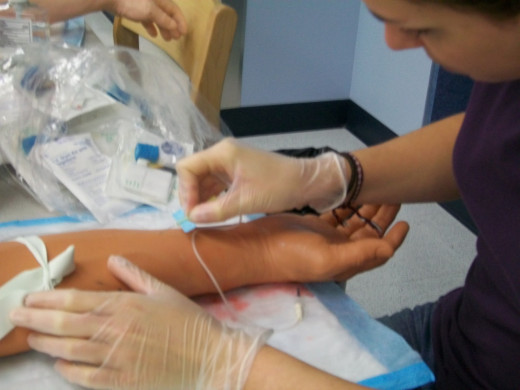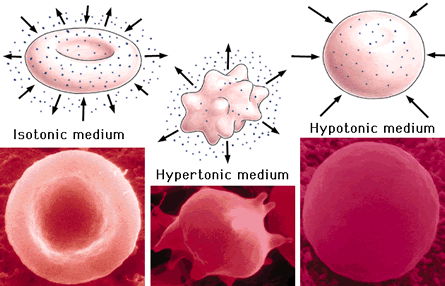IV Certification For LPN; What You Need to Know

Pass the Test the First Time
One of the differences between an LPN and an RN is that LPN's cannot start IV's, fortunately LPN's can take a course and pass an exam to become IV certified. Here is an outline of what you will learn and what the key points will be on the certification test.
The practical part of the class is the easy part. You will be instructed on how to draw blood and start an IV, but the written part takes some thinking.
If you did not get heavily into Hype, Hyper or Isotonic solutions and their affects on cells, and electrolytes you have some studying to do.
Category I fluids: includes blood, blood products, vitamins and electrolytes.
Primary Infusion Line: the line which provides a direct infusion between the container and the peripheral vein.
Secondary Infusion Line: a line which provides infusion through a lateral access into a primary infusion line.
CAUTION: LPNs are not permitted to administer any IV medications via a primary line, secondary line (piggy back) or by push or bolus, and can Not give any fluids through central lines or draw blood through these lines.
The best veins for IV are determined by their being soft, spongy and resilient.
The Tonics
IV class focuses a great deal on understanding Hypo, hyper and isotonic, and how they affect cells. Probably at least 75% of your test will be based on a knowledge of these three solutions.
Isotonic- Hypertonic- Hypotonic

How Isotonic sholutions affect cells
An isotonic solution has the same solute concentration as serum and other body fluids. Infusing the solution doesn't alter the concentration of serum; therefore, osmosis doesn't occur (for osmosis to occur, there must be a difference in solute concentration between serum and the interstitial fluid.)
The isotonic solution stays where it is infused, inside the blood vessel, and doesn't affect the size of cells.
Examples of Isotonic Solutions and Considerations.
Examples
| Nursing considerations
|
|---|---|
Lactated Ringer's (275 mOsm/L)
| Because isotonic solutions expand the intravascular conpartment, closely monitor for signs of fluid overload.
|
Ringer's (275 mOsm/L)
| Because liver converts lactate to bicarbonate, don't give lactated Ringer's solution if te patient's blood pH exceeds 7.5
|
Dextrose 5% om water (D5W)
| Avoid giving D5W to a patientat risk for increased intracranial pressure because it acts like a hypotonic solution.
|
Hypotonic Examples and Some Considerations
Name
| General Considerations
|
|---|---|
Half-normal saline (154 mOsm/L)
| Administer cautiously. Hypotonic solutions cause a fluid shift from blood vessels into cells.
|
Dextrose 2.5% in water (126 mOsm/L)
| Don't give hypotonic solutions to patients at risk for increased ICP from stroke, head trauma, or neurossurgery.
|
0.33% sodium chloride
| Don't give hypotonic solutions to patients at risk for third space fluid shifts
|
Hypertonic
Examples of Hypertonic solutions
| General Considerations
|
|---|---|
Dextrose 5% in half normal saline (406 mOsm/L)
| Because hypertonic solutions greatly expand the intravascular compartment, administer them by IV pump and closely monitor patient for overload.
|
3% Sodium chloride (1,025 mOsm/L)
| Hypertonic solutions pull fluid from the intracellular compartment, so don't give them to a patient with a condition that causes cellular dehydration(diabetic ketoacidosis)
|
7.5% sodium chloride
| Don't give hypertonic solutions to a patient with impaired heard or kideny function
|
Keep These General Guidelines In Mind
Selecting a cannula for IV insertion
An over the needle catheter and winged (butterfly) cannula with attached tubing are ideal choices for veins of the hand or forearm.
- Over the needle catheters range from 3/4 inch to 1 1/4 inch
- Winged butterfly cannulas are between 3/4 and 1 inch long.
- Diameters range from 16-25 gauge. (Smaller the gauge,, the larger the needle)
- After insertion, you will withdraw the steel needle, leaving only the flexible catheter.
Choosing the right size:
Depending on the vein, the cannula and the type of therapy, the catheter should be as small as possible. This will lessen the risk of phlebitis.
- 24-22 for children and elderly
- 24-20 for medical patients and postoperative surgical patients.
- 18 gauge for surgical patients and blood administration.
- 16 gauge for trauma patients requiring large volumes of fluid rapidly.





